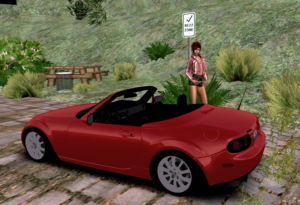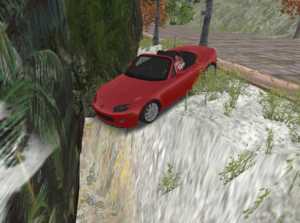
We all know STEM stands for Science, Technology, Engineering and Mathematics. Do y’all know that Second Life is a pretty good environment for catching young minds in a STEM web?
I stumbled into, at least what I think is, a pretty cool example of how an innocent foray into Second Life can stimulate a whole range of STEMistic explorations.
The other day, I was going down the yellow brick road… Oops, that’s another tale. The other day I was driving my cute, little red car down a Linden road on a mainland sim, when I crossed a region boundary and found my car and I tossed into the air and nearly over a cliff!
Whoa! What just happened there? Understanding why my car and I got tossed opens up a whole Pandora’s box of scientific, technological, engineering and mathematical possibilities. But I’m getting ahead of myself. Let me digress.
A long time ago, I was in a graduate program to become a school psychologist and I learned about a wonderful, if controversial, English boarding school that truly encouraged creative thinking and free learning. This school was called Summerhill and was founded by A. S. Neill in 1921. Summerhill exists today still (see link below). Neill’s philosophy was that children want to explore and learn and that traditional schools discourage a child’s freedom to find her own interests. I agreed with that philosophy and, in my teaching career amongst college students, I always tried to allow them to find their own ways through a particular subject.
As an aside, I did have a special passion for matrix algebra and did insist on students learning how to program matrix operations. I don’t think they ever appreciated the lovely magic of doing a multiple regression analysis with matrices. Oh well.
So, we are talking about how to use Second Life as a STEM laboratory. Let us return now to my example. Assume you assign your students the task of finding some form of transportation (a car, boat or airplane) and going to a location where they can drive, float or fly across a region boundary. Ask them to discover why that transition often results in chaos.
This assignment is really quite engaging (at least for me who probably has too much time on my hands at the moment). I of course immediately did a Google search about “sim crossings in Second Life” to start. I followed several threads and found a number of interesting articles.
First off, was the article by animats (see below for link) that introduced me to the Second Life viewer feature called “Velocity Interpolate Objects.” This feature reduces jaggy movements by interpolating between time points. This article led me to discussions of velocity and acceleration and finally to a really engaging article by Revesz (See below).
On another tack, I ran across this neat article about the physics of Second Life and how the surreal aspects of those physical properties could be used in physics education. (See Dos Santos Below).
If one were to bring together the students to discuss what they discovered about “sim crossing behaviors in Second Life” I feel a really interesting session would ensue. It really does not matter what students locate or if they figure out why sim crossings have problems. What matters is they share what captured their interest and that discussion is generated. Discussion well fed leads to ideas and motivation. An enthusiastic student is my goal in education.
References
- A. S. Neill’s Summerhill website.
- Vehicles vs. sim crossings, why it’s so awful, animats, General Second Life Tech Discussion, November 30, 2017.
- How movement works, Second Life Wiki.
- Interpolation (computer graphics), Wikipedia.
- What is the Difference Between Velocity and Acceleration?, Lee Johnson, Sciencing, March 14, 2018.
- Inertial Navigation by Interpolating the Flight Path of Moving Objects Based on Acceleration or Velocity Measurements, Peter Z. Revesz, International Journal of Mathematical Models and Methods in Applied Sciences, Volume 9, 2015. (This was the most interesting article I found)
- Second Life Physics : Virtual, Real or Surreal?, Renato P. Dos Santos, Journal of Virtual Worlds Research, 2(1), 1-21, March 2009.
 |
| Visits: 1623292 |
